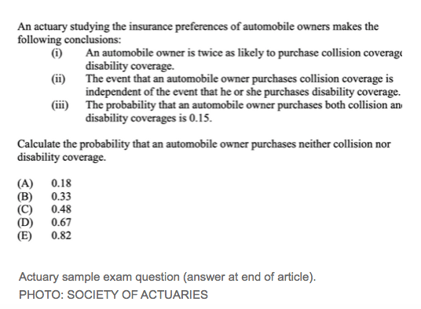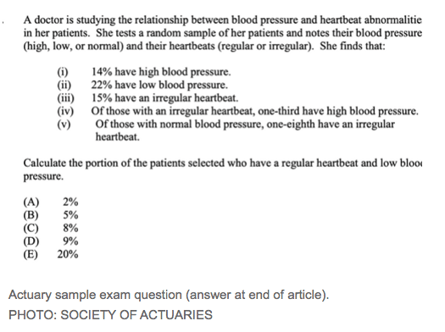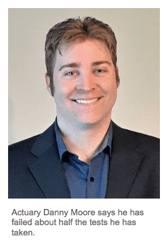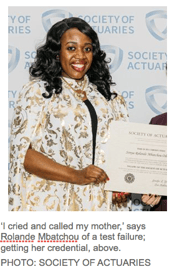Compass Agent Blog
Want to Be an Actuary? Odds Are, You’ll Fail the Test
By Neal Templin
Kaylee Cohen studied two months for an actuarial exam last year—then failed it. She dreaded telling the actuaries at the insurance company where she was interning that she had flunked.
“But when I told them, they said, ‘Oh yeah, I failed that one too,’ ” says the 23-year-old student at Montreal’s Concordia University. “It made me feel so much better knowing everybody else was in the same shoes.” She finally passed that exam and now has several more to go for an actuarial credential.
Actuaries quantify risk. One of their riskiest endeavors is trying to become one.
Among people taking at least one exam from the Society of Actuaries—the field’s biggest U.S. credentialing body—15% eventually pass the multiple tests required to become an Associate, one of two designations allowing them to practice. Just 10% pass those and additional tests to become a Fellow, the group’s higher designation, which affords bigger responsibilities and salaries.
It’s such an arduous process that the number of test-takers has been declining in recent years, and the society is making changes to keep candidates from dropping out of the gantlet. It is also adding new “predictive analytics” tests to adjust to the massive amounts of data insurers now have.
There is no limit to how many times a candidate can take the tests. It took one man 50 years to become a Fellow, says Stuart Klugman, an official at the society. The society says a candidate typically takes seven to 10 years to become a Fellow. They must pass 10 exams plus other coursework and requirements.
Among sample exam questions:
“An urn contains 10 balls: 4 red and 6 blue. A second urn contains 16 red balls and an unknown number of blue balls. A single ball is drawn from each urn. The probability that both balls are the same color is 0.44.”
“Calculate the number of blue balls in the second urn.” (Find the answer at the end of this article.)
Kelly Hanlon, a 22-year-old University of Wisconsin student, says she took the actuarial exam on probability—one of the tests required to become an Associate—in July 2020.
She failed. She took it again.
She came closer but failed, then took it a third time this January. “I studied until I could do the problems in my sleep,” she says.
She teared up, she says, when she saw her passing score.
Actuaries calculate the odds of something happening, typically for an insurer, and how to charge for that risk or what reserves to set aside.
In life insurance, actuaries calculate how long customers are likely to live and how much to charge them in premiums. Most insurers require that credentialed actuaries sign off on certain financials.
Now the actuaries society is changing some of the nation’s most demanding exams to adapt to the era of Big Data, which is transforming insurance underwriting with a flood of new information about people. Before, insurers might set rates based on four or five factors; they now consider dozens.

Insurers are hiring data scientists, and some actuarial students are switching to data science, knowing they can earn as much without enduring actuarial exams.
The Society of Actuaries, with fewer candidates for its tests, has begun giving what it calls micro-credentials to those who have passed a portion of required exams. And it is rolling out new predictive-analytics exams to test the data-science chops of would-be actuaries.
Julia Perugini, 24, of Montreal took the first such test in 2018. The entire exam centered on a mine workers union that wanted to identify the safest mines. The exam gave test-takers a computerized data package, asked them to write code and predict the rate of injury for a given mine, and required they defend the modeling methodology they used. Then they had to write an executive summary.
All in five hours. “You have to almost write like a 15-page essay,” Ms. Perugini says, “and we’re not big word people.”
She passed.

Anybody can take these exams. “We have no prerequisites to enter our system and come out the other end,” says Mr. Klugman, who helps prepare exam questions. “Just pass our exams.”
The actuaries society next year begins a program in which students at a few universities with actuarial-science programs will be able to forgo certain credentialing exams by taking classes on the same subject matter and passing their tests there.
“The professor may say if you get a 70 in the exam, you pass the class,” Mr. Klugman says. “And we may say you need a 90.”
Ken Williams, staff actuary at Casualty Actuarial Society, which credentials actuaries for property and casualty insurers, says the group is trying to encourage more people to join the profession.
“At the same time, we want to keep the same rigor in our tests,” he says. That rigor goes way back: Mr. Williams, of Bloomington, Ill., says he began taking exams in 1990, married in 1998 and became a Fellow in 2000. “I personally had a goal to get my fellowship done before we had kids, and I barely hit that.”
 Danny Moore, 38, trained as a cellist at the University of Cincinnati’s College-Conservatory of Music. He returned to his home state of Texas, he says, and spent a decade teaching music and trying to land a symphony job before deciding to become an actuary.
Danny Moore, 38, trained as a cellist at the University of Cincinnati’s College-Conservatory of Music. He returned to his home state of Texas, he says, and spent a decade teaching music and trying to land a symphony job before deciding to become an actuary.
He has passed the exams to become an Associate of the Society of Actuaries and is now shooting for the Fellow designation. He says he has failed about half the tests he has taken.
“Because of life and family,” he says, “I can only get in two or three hours of studying a day.”
Stefanos Orfanos, a mathematics Ph.D., taught actuarial science and decided to take credentialing exams to see what his students faced. He became a Fellow in 3½ years, he says.
The math wasn’t hard, but he failed a couple of exams because he didn’t answer questions fast enough, he says. “I lost track of the time I spent on problems,” says Dr. Orfanos, 41, who now directs the undergraduate actuarial-science program at Georgia State University. “I realized I should not try to impress the grader.”
 Rolande Mbatchou, having majored in mathematics and finance, figured in 2007 that she was ready for her first actuarial exam on mathematical finance.
Rolande Mbatchou, having majored in mathematics and finance, figured in 2007 that she was ready for her first actuarial exam on mathematical finance.
She wasn’t. Actuarial tests are graded on a 10-point scale. The lowest passing score is 6. Ms. Mbatchou says she received a 2.
“It was terrible,” she says. “I cried and called my mother in Paris. I thought it wasn’t for me.”
Ms. Mbatchou didn’t give up, though she stopped taking actuarial exams for four years to work at a startup. She passed the final test last year and became a Fellow at a ceremony this month.
Now 33 and living in Chicago, she mentors Black actuarial students: “I say, ‘I failed my first test with a 2, and here I am today.’ ”
(Test answers: urn question, 4 balls; question 11, B; question 12, E. For more sample questions, please click here; for answers, please click here.)
Copyright ©2021 Dow Jones & Company, Inc. All Rights Reserved. 87990cbe856818d5eddac44c7b1cdeb8
Appeared in the December 29, 2021, print edition.
Website - https://www.wsj.com/articles/actuary-credential-test-exam-bad-odds-11640706082 st=3qjhqsu7ng82mm4&reflink=article_email_share
